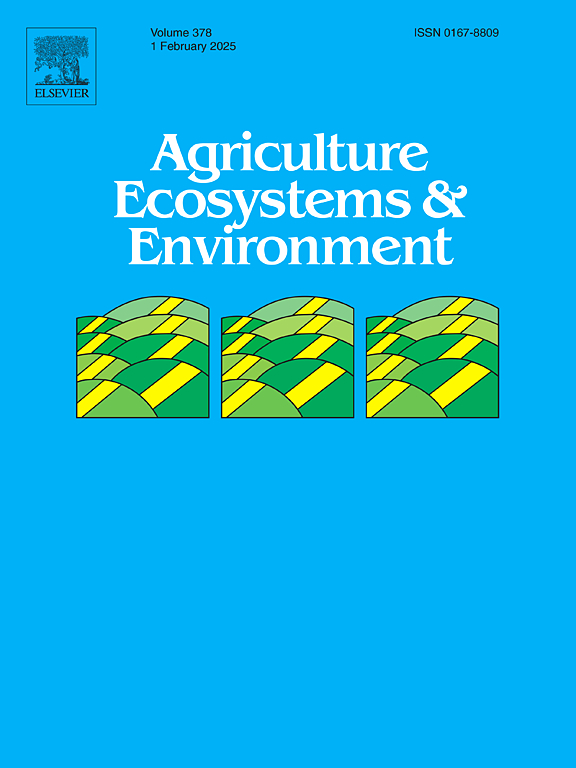Potato–rice and garlic–rice rotation increases soil phosphorus availability through phosphate-solubiliing bacteria and root exudates in upland–paddy cropping systems
IF 6
1区 农林科学
Q1 AGRICULTURE, MULTIDISCIPLINARY
引用次数: 0
Abstract
Various agricultural soils contain substantial phosphorus (P); however, crops frequently fail to fully utilize it. Assessing the P status of upland–paddy cropping soil is essential for efficient use of stored P in the soil and minimizing reliance on external P input, thereby mitigating environmental pollution. We examined P availability and changes in inorganic P fractions, identified the key inorganic P fractions that affect P availability, and explored the mechanisms underlying for P availability with regard to rhizosphere traits and P-solubilizing bacteria (PSB) in upland–paddy cropping systems. Three upland–paddy cropping systems, i.e., garlic–rice (GR), wheat–rice (WR), and potato–rice (PR), were evaluated in multiple cropping regions during 2018–2019 and 2019–2020. Soil P availability, inorganic P fractions, PSB, rhizosphere traits, and their relationships, were investigated. The apparent P balances were in surplus, with a significant proportion of input P (52.38 %–97.61 %) either present in the soil or lost. Soil available P and the P activation coefficient were ranked as PR > GR >WR; however, the environmental risk threshold of GR and PR exceeded that of WR. The effective P and slow-release P sources in GR (4.40 % and 51.01 %, respectively) and PR (5.55 % and 51.53 %, respectively) were higher than those in WR (3.70 % and 39.37 %, respectively). In comparison, the potential P sources were higher in WR (56.63 %) than in GR (44.57 %) and PR (42.92 %). Soil inorganic P accounted for 47.72 %–73.50 % of total P. The key inorganic P fractions were Ca2-P, Ca8-P, Fe-P, and O-P in GR; Ca2-P, Ca8-P, and Fe-P in PR; and Ca2-P, Ca8-P Al-P, Fe-P and Ca10-P in WR. Except for acid phosphatase, organic acids had the strongest influence on P availability in GR, and PSB were the most important influence factor in PR. In WR, PSB, acid phosphatase, or organic acids had a weaker effect. Thus, compared to WR, PR and GR had higher P availability by changing inorganic P fractions and improving the PSB abundance and rhizosphere traits. PR and GR had great potential for reducing P fertilizer usage and mitigating environmental risks. These findings may provide a theoretical basis for utilizing residual P in soil.
马铃薯-水稻和大蒜-水稻轮作在旱地水稻种植系统中通过溶磷细菌和根系分泌物增加了土壤磷的有效性
各种农业土壤含有大量的磷(P);然而,作物往往不能充分利用它。评估旱地水稻种植土壤的磷状况对于有效利用土壤中储存的磷,减少对外部磷输入的依赖,从而减轻环境污染至关重要。研究了旱作水田土壤磷有效性和无机磷组分的变化,确定了影响磷有效性的主要无机磷组分,探讨了旱作水田土壤根际性状和溶磷细菌(PSB)对磷有效性的影响机制。在2018-2019年和2019-2020年对3种旱田水稻种植制度,即大蒜-水稻(GR)、小麦-水稻(WR)和马铃薯-水稻(PR)进行了评价。研究了土壤磷有效性、无机磷组分、PSB、根际性状及其相互关系。土壤磷的表观平衡处于盈余状态,输入磷在土壤中存在或流失的比例显著(52.38 % ~ 97.61 %)。土壤有效磷和磷活化系数依次为PR >; GR >;WR;但GR和PR的环境风险阈值高于WR。GR(4.40 %和51.01 %)和PR(5.55 %和51.53 %)的有效磷源和缓释磷源均高于WR(3.70 %和39.37 %)。相比之下,WR的潜在P源(56.63 %)高于GR(44.57 %)和PR(42.92 %)。土壤无机磷占总磷的47.72 % ~ 73.50 %,土壤中主要无机磷组分为Ca2-P、Ca8-P、Fe-P和O-P;PR中的Ca2-P、Ca8-P和Fe-P;WR中的Ca2-P、Ca8-P、Al-P、Fe-P和Ca10-P。除酸性磷酸酶外,有机酸对粗磷有效性的影响最大,PSB对粗磷有效性的影响最大,而在粗磷有效性中,PSB、酸性磷酸酶和有机酸的影响较弱。因此,与WR相比,PR和GR通过改变无机磷组分,改善PSB丰度和根际性状,具有更高的磷有效性。PR和GR在减少磷肥使用和减轻环境风险方面具有很大的潜力。研究结果可为土壤残磷的合理利用提供理论依据。
本文章由计算机程序翻译,如有差异,请以英文原文为准。
求助全文
约1分钟内获得全文
求助全文
来源期刊

Agriculture, Ecosystems & Environment
环境科学-环境科学
CiteScore
11.70
自引率
9.10%
发文量
392
审稿时长
26 days
期刊介绍:
Agriculture, Ecosystems and Environment publishes scientific articles dealing with the interface between agroecosystems and the natural environment, specifically how agriculture influences the environment and how changes in that environment impact agroecosystems. Preference is given to papers from experimental and observational research at the field, system or landscape level, from studies that enhance our understanding of processes using data-based biophysical modelling, and papers that bridge scientific disciplines and integrate knowledge. All papers should be placed in an international or wide comparative context.
 求助内容:
求助内容: 应助结果提醒方式:
应助结果提醒方式:


